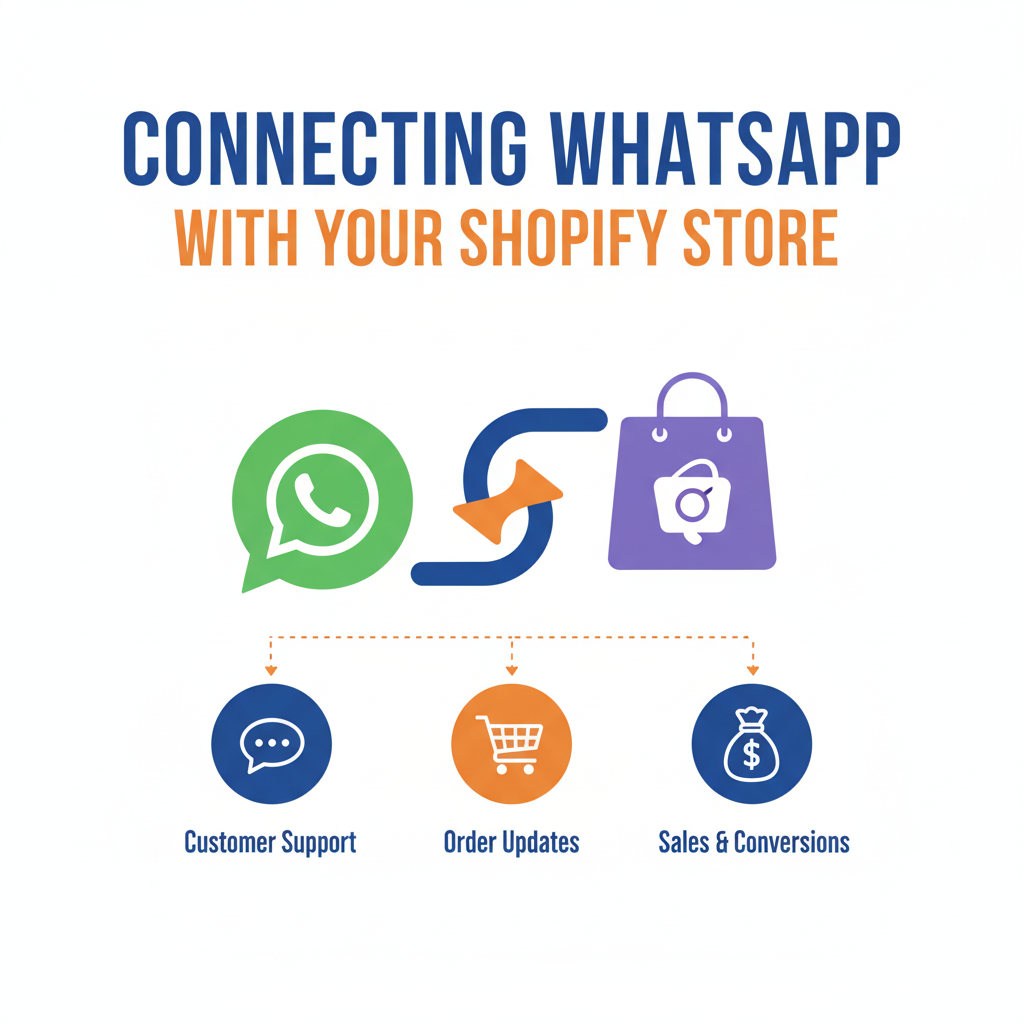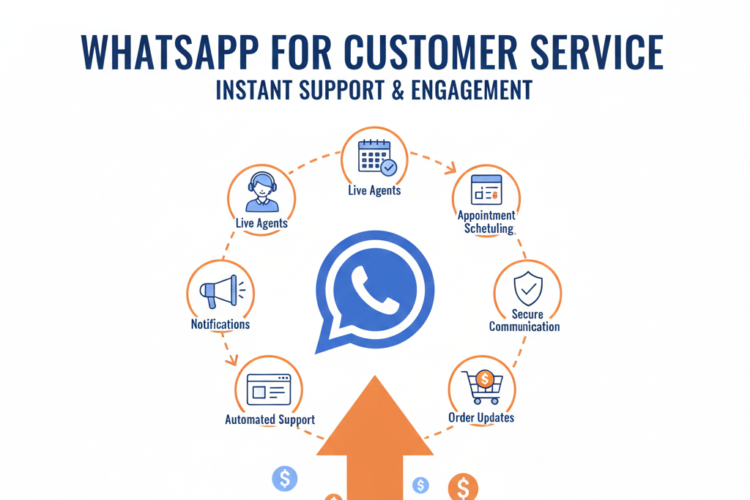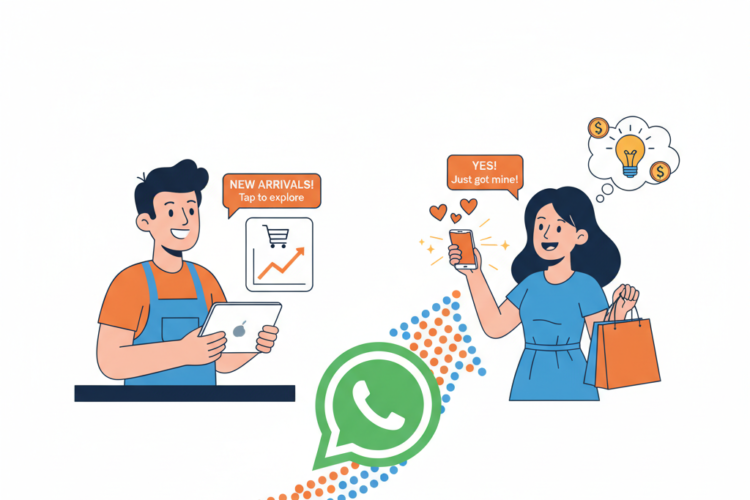
Connecting WhatsApp with Your Shopify Store for Enhanced Sales, Automated Support & Seamless Customer Engagement
1. Introduction: Why WhatsApp Matters for Shopify Businesses
In eCommerce, speed and personalization often determine whether a visitor becomes a buyer. Customers no longer want to fill long forms or wait for email replies — they expect instant, human-like communication.
That’s where WhatsApp integration with Shopify comes in.
With over 2.8 billion monthly active users, WhatsApp has evolved from a messaging platform into a full-fledged business communication channel. Integrating it with your Shopify store allows you to chat directly with customers, provide automated order updates, and even close sales inside WhatsApp.
It’s fast, personal, and highly effective for conversions, retention, and customer satisfaction.
2. Benefits of Connecting WhatsApp with Shopify
Integrating WhatsApp into your Shopify ecosystem can dramatically elevate your customer experience and sales funnel. Here’s how:
a. Instant Customer Communication
Answer product questions in real time.
Reduce cart abandonment with quick clarifications.
Build trust through personal interactions.
b. Automated Support
Send automated replies to FAQs (order tracking, returns, delivery status).
Offer 24/7 assistance without hiring additional support staff.
Use chatbots to triage customer queries and forward complex cases to human agents.
c. Boost Sales Conversion
Recover abandoned carts with personalized reminders.
Share discount codes or personalized recommendations via WhatsApp.
Enable “Buy Now” links directly in the chat to complete purchases faster.
d. Strengthen Customer Engagement
Notify customers about back-in-stock items or price drops.
Send product launch alerts and promotional campaigns.
Build loyalty through personalized follow-ups and feedback collection.
e. Build Credibility and Trust
Unlike generic emails, WhatsApp creates a one-on-one, secure connection. When customers can talk to a verified WhatsApp Business number, they trust your brand more.
3. How to Connect WhatsApp with Shopify
You can integrate WhatsApp with your Shopify store in multiple ways depending on your goals — from basic chat buttons to full automation through APIs.
Option 1: WhatsApp Chat Button on Storefront
Best For: Real-time visitor communication
Steps:
Go to the Shopify App Store.
Search for “WhatsApp Chat” or “WhatsApp Chat Button.”
Choose an app like:
WhatsApp Chat + Abandoned Cart by SuperLemon
Tidio Live Chat & WhatsApp
WhatsApp & Messenger Chat by Pushdaddy
Install and customize your chat button (color, position, greeting).
Link your official WhatsApp Business number.
✅ Result: Visitors can instantly message you without leaving your store.
Option 2: WhatsApp API Integration (Advanced)
Best For: Automated workflows, order notifications, and CRM sync.
Steps:
Create a WhatsApp Business Account and verify it via Meta Business Manager.
Get API access via:
Meta’s Official WhatsApp Business API, or
Providers like Twilio, WATI, 360Dialog, Zoko, or Interakt.
Connect your API account to Shopify using approved apps.
Configure automated workflows:
Order Confirmation
Shipping Updates
Cart Recovery
COD Verification
✅ Result: You can send personalized, automated WhatsApp messages triggered by customer actions — with analytics tracking.
Option 3: Shopify Marketing Automation via WhatsApp
Best For: Campaigns, promotions, and segmentation.
You can integrate WhatsApp into marketing tools like:
Klaviyo
Omnisend
Zoko
Interakt
WATI
These let you:
Segment customers based on behavior.
Send broadcast campaigns (offers, new arrivals).
Track message delivery, open rates, and conversions.
4. Key WhatsApp Automation Workflows for Shopify
Here are top-performing automation ideas that drive sales and retention:
a. Abandoned Cart Recovery
“Hey [Name], you left something special in your cart! Complete your purchase now and enjoy 10% off. Click here 👉 [Cart Link].”
This approach can recover up to 30% of abandoned carts.
b. Order Confirmation & Shipping Updates
Automate confirmations like:
“Thanks for shopping with us, [Name]! Your order #[Order ID] has been confirmed. We’ll notify you once it’s shipped.”
This improves transparency and reduces customer support load.
c. Customer Re-engagement
“We miss you, [Name]! Check out our new arrivals this week — exclusive 15% off for you.”
Perfect for dormant customers and remarketing campaigns.
d. COD Verification & Reminders
For Cash-on-Delivery orders:
“Please confirm your COD order #[Order ID] by replying YES. This helps us ship faster!”
Reduces return-to-origin (RTO) rates.
e. Review & Feedback Requests
“Hey [Name], how was your shopping experience with us? Share your feedback — it helps us serve you better!”
Enhances brand trust and improves customer retention.
5. WhatsApp Business vs. WhatsApp Business API
| Feature | WhatsApp Business App | WhatsApp Business API |
|---|---|---|
| Best For | Small businesses | Medium to large brands |
| Setup | Simple app download | Requires approval and setup |
| Automation | Limited | Fully automated workflows |
| Message Volume | Manual | Scalable (bulk messaging allowed) |
| Integration | Minimal | Deep CRM + Shopify integration |
| Cost | Free | Pay-per-message model |
If you’re scaling your Shopify brand, moving to the API version unlocks automation, analytics, and team collaboration.
6. Compliance and WhatsApp Marketing Rules
Before you start messaging, understand WhatsApp’s compliance guidelines:
Consent is mandatory. You must get explicit opt-in before sending marketing messages.
Use approved templates for transactional messages (e.g., order updates).
No spam or cold messaging. Violating policies can lead to suspension.
Display your brand name clearly and use professional messaging tone.
Tip: Include a WhatsApp opt-in checkbox during checkout or newsletter sign-up to stay compliant.
7. Measuring Success: Key Metrics to Track
| Metric | What It Indicates |
|---|---|
| Message Open Rate | Engagement level (usually 90%+) |
| Response Rate | Effectiveness of message tone |
| Click-Through Rate (CTR) | Interest in shared products or links |
| Conversion Rate | How many chats lead to sales |
| Customer Satisfaction (CSAT) | Support efficiency |
| RTO Reduction | Logistics performance post-verification |
Use analytics dashboards from your integration provider to track these KPIs.
8. Real-World Example: WhatsApp + Shopify Success Story
Brand: The Souled Store
Integration: WhatsApp API with Interakt
Results:
35% increase in abandoned cart recovery rate
50% faster response times for customer queries
20% boost in repeat purchases through personalized campaigns
This shows how real-time communication builds relationships and drives measurable ROI.
9. Best Practices for WhatsApp-Shopify Integration
✅ Keep messages short, friendly, and branded.
✅ Use rich media — images, GIFs, product carousels.
✅ Automate but don’t overdo it — mix in human support.
✅ Offer opt-outs easily (respect user privacy).
✅ Test and personalize constantly.
10. Conclusion: Turning WhatsApp into a Growth Engine
Integrating WhatsApp with your Shopify store is no longer just a convenience — it’s a competitive advantage. It connects your store and customers in real time, drives more conversions, and enhances post-purchase satisfaction.
From instant product support to automated order tracking and personalized re-engagement, WhatsApp transforms your eCommerce journey into a conversational, customer-first experience.
If you want to build a future-ready store, WhatsApp should be at the core of your communication and conversion strategy.
Author



